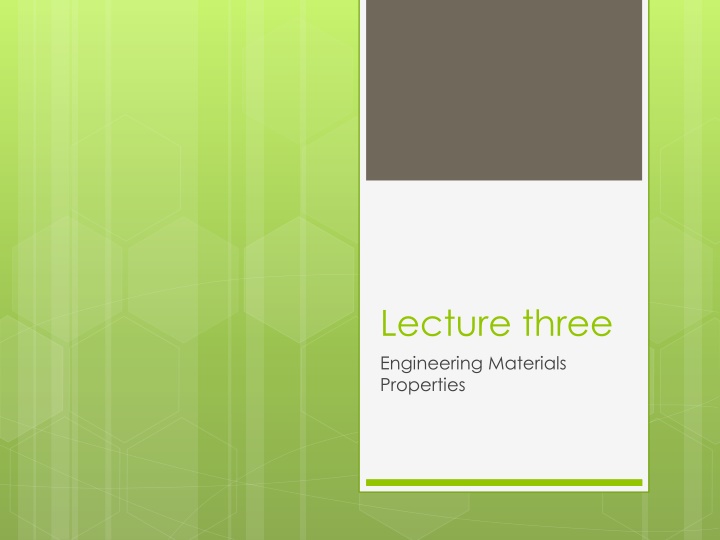
Engineering Material Properties - Mechanical, Thermal, and More
Explore the key properties of engineering materials, including mechanical characteristics like strength, stiffness, hardness, and toughness. Delve into thermal aspects such as heat capacity, thermal expansion, and thermal conductivity. Discover how materials respond to heat and the transfer of thermal energy. Gain insights into the essential properties that define the behavior and performance of materials in various applications.
Download Presentation

Please find below an Image/Link to download the presentation.
The content on the website is provided AS IS for your information and personal use only. It may not be sold, licensed, or shared on other websites without obtaining consent from the author. If you encounter any issues during the download, it is possible that the publisher has removed the file from their server.
You are allowed to download the files provided on this website for personal or commercial use, subject to the condition that they are used lawfully. All files are the property of their respective owners.
The content on the website is provided AS IS for your information and personal use only. It may not be sold, licensed, or shared on other websites without obtaining consent from the author.
E N D
Presentation Transcript
Lecture three Engineering Materials Properties
Material properties The various properties of materials are classified as follows: Mechanical properties: there are many mechanical properties as in figure (3-1), below some of them: Strength : It is defined as resistance by which the material opposes the deformation. The maximum load withstood by a specimen of the metal before failure is called ultimate strength. The load acting per unit area of specimen is called stress and the deformation produced is called strain Stiffness: Is defined as its resistance to elastic deformation.or it s the slop of the hoocks law .a material which undergoes a slight deformation under the action of load is said to posess high degree of stiffness.
Hardness: It is the property of which material resist the penetration of other bodies into it. Hardness measurement can be defined as macro-, micro- or nano- scale according to the forces applied and displacements obtained . Toughness: It is the ability of a material to resist fracture under impact load ,or its the area under the stress-strain curve. tough materials can withstand large deformation together with high stress without fracture.
Thermal properties Thermal property refers to the response of a material to the application of heat. As a solid absorbs energy in the form of heat, its temperature rises and its dimensions increase. Heat capacity, thermal expansion, and thermal conductivity are properties that are often critical in the practical utilization of solids. Heat capacity A solid material, when heated, experiences an increase in temperature signifying that some energy has been absorbed. Heat capacity is a property that is indicative of a material s ability to absorb heat from the external surroundings; it represents the amount of energy required to produce a unit temperature rise. Thermal expansion Most solid materials expand upon heating and contract when cooled. The change in length with temperature for a solid material may be expressed as follows: Where l0and lfrepresent, respectively, initial and final lengths with the temperature change from T0to Tf. The parameter lis called the linear coefficient of thermal expansion; it is a material property that is indicative of the extent to which a material expands upon heating.
Thermal conductivity Thermal conduction is the phenomenon by which heat is transported from high- to low-temperature regions of a substance. The property that characterizes the ability of a material to transfer heat is the thermal conductivity.
Electrical, Magnetic And Optical Properties We start with electrical conduction and insulation (Figure 3.2(a)). Without electrical conduction we would lack the easy access to light, heat, power, control and communication that today we take for granted. Metals conduct well copper and aluminum are the best of those that are affordable. But conduction is not always a good thing. Fuse boxes, switch casings, all require insulators. Here the property we want is resistivity, the inverse of electrical conductivity. Most plastics and glass have high resistivity (Figure 3.2(a)) they are used as insulators. Electricity and magnetism are closely linked. Electric currents induce magnetic fields; a moving magnet induces an electric current. Some metals called ferromagnets because have the capacity to trap a magnetic field permanently. These are called hard magnetic materials because, once magnetized, they are hard to demagnetize. They are used as permanent magnets in headphones, motors and dynamos. Here the key property is the remanence, a measure of the intensity of the retained magnetism.
Electrical, Magnetic And Optical Properties Figure 3.2
A few others demagnetize. They are the materials of transformer cores. They have the capacity to conduct a magnetic field, but not retain it permanently (Figure 3.2(b)). For these a key property is the saturation magnetization, which measures how large a field the material can conduct. Materials that are opaque reflect light; those that are transparent refract it, and some have the ability to absorb some wavelengths (colors) while allowing others to pass freely (Figure 3.2(c)). soft Magnet materials are easy to magnetize and






















